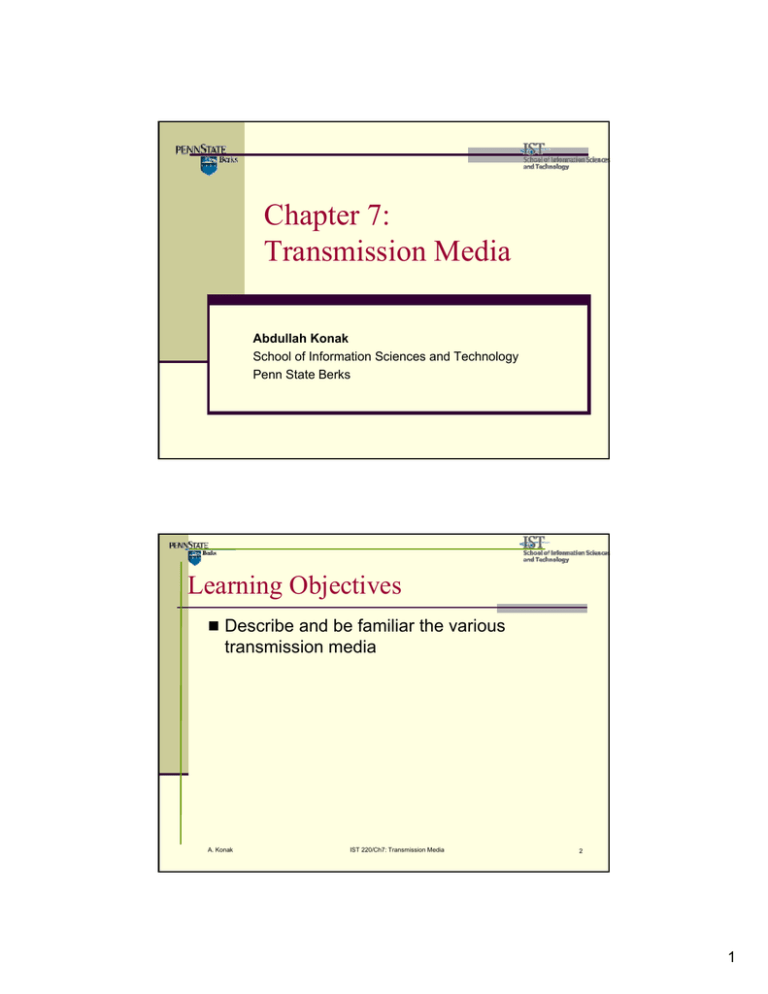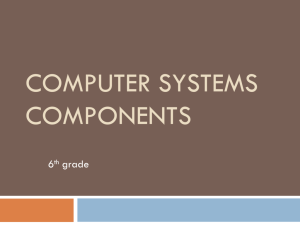Chapter 7: Transmission Media Learning Objectives Describe and be familiar the various
advertisement

Chapter 7: Transmission Media Abdullah Konak School of Information Sciences and Technology Penn State Berks Learning Objectives Describe and be familiar the various transmission media A. Konak IST 220/Ch7: Transmission Media 2 1 Transmission Media Media Guided Media Twisted Pair Unguided Media Coaxial Shielded Baseband Unshielded Broadband A. Konak Optical Fiber Radio Microwaves Terrestrial Microwave Infrared Satellite Microwave IST 220/Ch7: Transmission Media 3 Twisted Pair Source of Interference (Electromagnetic waves) Noise on the cable, created by the other devices. Noise on each cable cancels (evens) each other out at the end. A. Konak IST 220/Ch7: Transmission Media 4 2 Twisted Pair Types: UTP and STP Unshielded Twisted Pair (UTP) Jacket/sheath Shielded Twisted Pair (STP) A. Konak IST 220/Ch7: Transmission Media 5 Category 3 (CAT3) and CAT5 A. Konak IST 220/Ch7: Transmission Media 6 3 Straight-Through CAT 5 with RJ-45 Connectors A. Konak IST 220/Ch7: Transmission Media 7 Crossover Cable CAT 5 with RJ-45 Connectors A straight-thru cable has identical ends. A crossover cable has different ends. A. Konak IST 220/Ch7: Transmission Media 8 4 Coaxial Cable (Coax) A. Konak IST 220/Ch7: Transmission Media 9 Baseband vs Broadband Coax Baseband Broadband Unmodulated digital signal. Single channel. Bidirectional propagation of signal. Stations connected via T connectors. No need of modems - low cost installation. ADVANTAGES: Simplicity Low cost Ease of installation and maintenance High rates DISADVANTAGES: A. Konak Limited distances Data and voice only Digital signal modulated onto RF carrier (analog). Channel allocation based on FDM. Head-End for bidirectional transmission. Stations connected via RF modems. ADVANTAGES: Data, voice and video Greater distances Greater bandwidth DISADVANTAGES: Cable design Alignment and maintenance High cost, requires modems Lack of well developed standards IST 220/Ch7: Transmission Media 10 5 Fiber Optic A. Konak IST 220/Ch7: Transmission Media 11 Guided Transmission Media Performance Medium Cost Throughput Attenuation Interference Security UTP Low Up to 100 Mbps High High Low STP Moderate Up to 150 Mbps High Moderate Low Coaxial Moderate Up to 1 Gbps Moderate Moderate Low Optical Fiber High Up to 2 Gbps Low Low High A. Konak IST 220/Ch7: Transmission Media 12 6 Unguided Medium microwave and infrared are suitable for point-to-point transmission radio waves are omnidirectional The smaller the wavelength (the higher frequency), the more suitable waves for point-to-point transmission Radio Waves: 100,000 km (3Hz) to 30cm (1GHz). Microwaves: 30 cm (1 GHz) to 1cm (30 GHz). Infrared: 1 mm (300 GHz) to 750 μ m (400 THz). Laser (future) A. Konak IST 220/Ch7: Transmission Media 13 Electromagnetic Radio Waves Spectrum in Telecommunications Band Frequency Common Uses Very Low Frequency (VLF) 10 kHz to 30 kHz Marine-time ship-to-shore Low Frequency (LF) 30 kHz to 300 kHz Cordless phones Medium Frequency (MF) 300 kHz to 3 MHz AM Radio High Frequency (HF) 3 MHz to 30 MHz Shortwave radio, CB radio Very High Frequency (VHF) 30 MHz to 144 MHz 144 MHz to 174 MHz 174 MHz to 328.6 MHz TV Stations 2-6, FM radio Taxi Stations TV Stations 7-13 Ultra High Frequency (UHF) 328.6 MHz to 450 MHz 450 MHz to 470 MHz 470 MHz to 806 MHz 806 MHz to 960 MHz 960 MHz to 2.3 GHz 2.3 GHz to 2.9 GHz Public safety Cellular and PCS phones Pagers PCS phones Air traffic control radar WLAN (802.11b) Super High Frequency (SHF) 2.9 GHz to 30 GHz WLAN(802.11a) Extremely High Frequency (EHF) 30 GHz and above high-speed microwave data links A. Konak IST 220/Ch7: Transmission Media 14 7 Examples AM radio - 535 KHz to 1.7 MHz Television stations - 54 to 88 MHz for channels 2 through 6 FM radio - 88 MHz to 108 Mhz Television stations - 174 to 220 Mhz for channels 7 through Garage door openers, alarm systems, etc. - Around 40 Mhz Standard cordless phones: Bands from 40 to 50 Mhz Baby monitors: 49 Mhz Radio controlled airplanes: Around 72 megahertz, which is different from... Radio controlled cars: Around 75 megahertz Wildlife tracking collars: 215 to 220 megahertz MIR space station: 145 megahertz and 437 megahertz Cell phones: 824 to 849 megahertz New 900-MHz cordless phones: Obviously around 900 megahertz! Air traffic control radar: 960 to 1,215 megahertz Global Positioning System: 1,227 and 1,575 megahertz Deep space radio communications: 2290 megahertz to 2300 megahertz A. Konak IST 220/Ch7: Transmission Media 15 Terrestrial Microwave Land based, line-of-sight transmissions Antenna: parabolic "dish“, 3 meters in diameters. Maximum 20-30 miles between towers High data rates Used by telephone companies and businessto-business transmission A. Konak IST 220/Ch7: Transmission Media 16 8 Terrestrial Microwave Antennaes A. Konak IST 220/Ch7: Transmission Media 17 Problems Attenuation increases with rainfall, especially above 10GHz. Overlapping transmission areas (frequency band control is necessary) A. Konak IST 220/Ch7: Transmission Media 18 9 Satellite Microwave Transmission a microwave relay station in space can relay signals over long distances geostationary satellites remain above the equator at a height of 22,300 miles (geosynchronous (GEO) orbit) travel around the earth in exactly the time the earth takes to rotate A. Konak IST 220/Ch7: Transmission Media 19 Satellite Positions A. Konak IST 220/Ch7: Transmission Media 20 10 Satellite Transmission Process satellite transponder dish dish 22,300 miles uplink station A. Konak downlink station IST 220/Ch7: Transmission Media 21 Infrared Uses transmitters/receivers (transceivers) that modulate noncoherent infrared light. Transceivers must be within line of sight of each other (directly or via reflection ). Unlike microwaves, infrared does not penetrate walls. A. Konak IST 220/Ch7: Transmission Media 22 11






